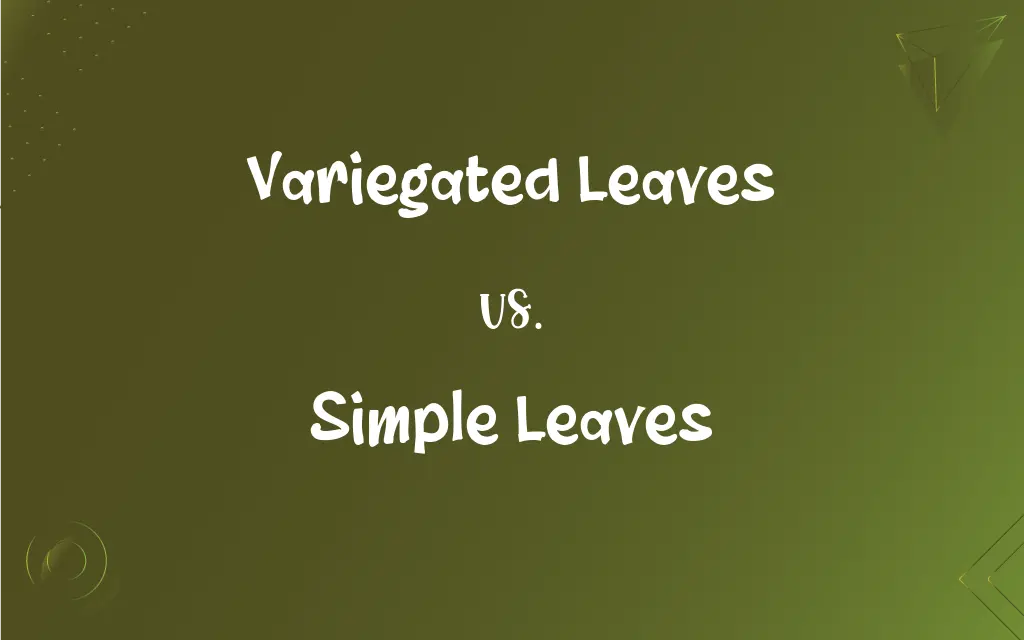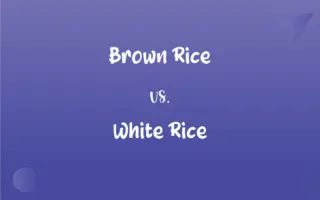Variegated Leaves vs. Simple Leaves: What's the Difference?
Edited by Aimie Carlson || By Janet White || Published on January 6, 2024
Variegated leaves have multiple colors due to irregular chlorophyll distribution, while simple leaves are single-colored with a uniform structure.

Key Differences
Variegated leaves display a mix of colors, such as green, white, and yellow, due to uneven distribution of chlorophyll and other pigments. This variation often occurs due to genetic factors or environmental conditions. In contrast, simple leaves are uniformly colored, usually green, due to consistent chlorophyll distribution, reflecting their primary function in photosynthesis.
The patterns in variegated leaves can vary greatly, with streaks, margins, or blotches, adding aesthetic value to plants. These patterns are the result of various pigment concentrations in different leaf areas. Simple leaves, however, have a consistent color and texture, which is typically a solid green, indicative of their focus on efficient photosynthesis.
Variegated leaves can sometimes have reduced photosynthetic efficiency due to less chlorophyll in parts of the leaf. This can impact the plant's growth rate and vigor. On the other hand, simple leaves are optimized for photosynthesis, supporting robust growth and development of the plant.
In gardening and horticulture, variegated leaves are often sought after for their decorative appeal and uniqueness. Conversely, simple leaves are appreciated for their natural beauty and their crucial role in supporting the health and growth of the plant.
Variegated leaves can occur in various plant species, they are often seen in ornamental plants. Simple leaves, being the more common type, are found across a wide range of plant species, from small herbs to large trees.
ADVERTISEMENT
Comparison Chart
Color Pattern
Multiple colors due to irregular chlorophyll
Uniformly green, consistent chlorophyll distribution
Photosynthetic Efficiency
Sometimes reduced due to less chlorophyll
Typically high, optimized for photosynthesis
Aesthetic Value
Highly decorative, with unique patterns
Natural and uniform beauty
Common Occurrence
Often in ornamental plants
Widespread in various plant species
Function
Primarily decorative, can impact plant growth
Focused on efficient photosynthesis, supporting growth
ADVERTISEMENT
Variegated Leaves and Simple Leaves Definitions
Variegated Leaves
Foliage exhibiting a mix of green, white, or yellow, often in unique patterns.
The snake plant's variegated leaves made it a striking houseplant.
Simple Leaves
Foliage with a single, solid color, optimized for photosynthesis.
The simple leaves of the maple efficiently capture sunlight.
Variegated Leaves
Leaves with irregular patches or streaks of different colors.
The variegated leaves of the hosta added contrast to the garden.
Simple Leaves
Uniformly colored leaves common in a wide variety of plant species.
The rose's simple leaves contribute to its overall health.
Variegated Leaves
Leaves with uneven chlorophyll distribution, resulting in a multi-colored appearance.
The variegated leaves of the ivy brightened the shaded area.
Simple Leaves
Single-colored leaves, indicative of consistent chlorophyll distribution.
The simple leaves of the grass covered the lawn uniformly.
Variegated Leaves
Ornamental leaves prized for their aesthetic appeal in landscaping.
Gardeners value variegated leaves for their visual interest.
Simple Leaves
Leaves of uniform color, typically green, with a consistent texture.
The oak tree's simple leaves were a vibrant green in summer.
Variegated Leaves
Plant leaves with color variations due to genetic or environmental factors.
The variegated leaves of the croton are a result of genetic mutation.
Simple Leaves
Basic leaf structure with a focus on efficient energy production.
The simple leaves of the apple tree support its fruit production.
FAQs
What is a simple leaf?
A leaf with a uniform color and structure, typically green.
What causes variegation in leaves?
Genetic factors or environmental conditions affecting chlorophyll.
Can variegation in leaves change over time?
Yes, based on environmental factors and plant maturity.
Do simple leaves have any color variations?
No, they are usually uniformly green.
Are variegated leaves less efficient in photosynthesis?
Yes, parts with less chlorophyll are less efficient.
Do all plants have the potential for variegated leaves?
Not all, it often occurs in specific ornamental species.
Are simple leaves better for plant growth?
Generally, yes, due to their efficient photosynthesis.
Can environmental stress affect simple leaves?
Yes, but they typically retain their uniform color.
Can variegated leaves revert to being simple?
Yes, especially if the variegation is unstable.
What types of plants commonly have simple leaves?
Many plants, including trees, shrubs, and herbs.
Are simple leaves always smooth?
Not necessarily; they can have various textures.
Can variegated leaves photosynthesize?
Yes, but less efficiently in the non-green areas.
Is the texture of variegated leaves different from simple leaves?
The texture can be similar, but the color pattern differs.
Are variegated leaves more popular in gardening?
They are popular for their decorative appeal.
Do variegated leaves require special care?
They may need more light to compensate for reduced photosynthesis.
Can variegated leaves occur in indoor plants?
Yes, many houseplants have variegated varieties.
How does pruning affect variegated leaves?
It can influence the pattern of variegation.
Do simple leaves change color in autumn?
Yes, in many species they change color before falling.
Are variegated leaves rare in nature?
Relatively, compared to simple leaves.
Do simple leaves have a single layer?
They have multiple layers but a uniform color.
About Author
Written by
Janet WhiteJanet White has been an esteemed writer and blogger for Difference Wiki. Holding a Master's degree in Science and Medical Journalism from the prestigious Boston University, she has consistently demonstrated her expertise and passion for her field. When she's not immersed in her work, Janet relishes her time exercising, delving into a good book, and cherishing moments with friends and family.
Edited by
Aimie CarlsonAimie Carlson, holding a master's degree in English literature, is a fervent English language enthusiast. She lends her writing talents to Difference Wiki, a prominent website that specializes in comparisons, offering readers insightful analyses that both captivate and inform.







































































